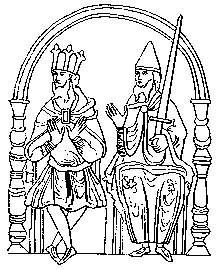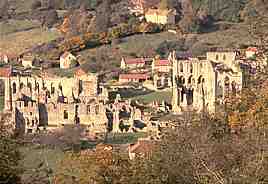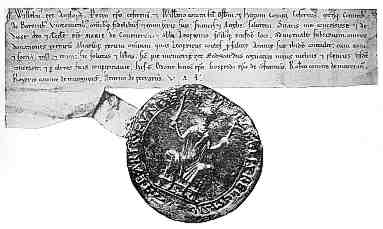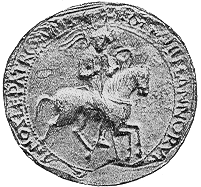



If you are looking at this page without frames, there is more information about medieval writing to be found by going to the home page (framed) or the site map (no frames).
| Royal Charters | |||||
| The term charter can be used with a very specific meaning or a more general one. Some books use the term charter for any form of written legal document. In a strict definition, a charter is a grant, particularly of land, by the sovereign. Under this definition, the royal diplomas of monarchs on the continent of Europe and papal bulls may also be charters. They are in separate sections here simply in order to point out their particular features. | |||||
| In an English context, royal charters were the first form of legal documentation. They were utilised by the Anglo-Saxon kings and proliferated under the Normans, as monastic institutions and members of the aristocracy scrambled to assert their rights over bits of territory under the new dispensation. The charter form was later used by aristocrats and others of means in relation to donations to religious institutions or to publicly ratify business arrangments. |
 |
||||
 |
Monasteries and other religious institutions were generally engaged in economically non-productive activities in the course of their devotional duties. They relied on the income generated from farms and other lands to maintain their large communities and support their programs of building. Grants of land which allowed them to exercise lordship over rural communities and the associated privileges were jealously guarded. Royal charters provided security for their functioning and many surviving charters represent grants to religious insitiutions. | ||||
| The ruins of the Cistercian abbey of Rievaulx in rural Yorkshire. | |||||
| The charter was essentially a public proclamation which granted rights in perpetuity. However, forever was not necessarily a long time in the turbulent politics of the middle ages. Some charters are confirmations of rights already granted by previous monarchs, just in case. Other charters have been found to be forged documents proclaiming rights allegedly granted by a previous monarch, just in case. The appearance and format of a charter reflects its role as a public document. | |||||
 |
Charter of William I of c.1070 to the church of St Mary at Coventry (British Library, add charter 11205). (From Johnson and Jenkinson 1915) | ||||
| The charter illustrated above shows certain defining characteristics of the document type. A charter consisted of a single leaf of parchment which was delivered open. It was ratified by the attachment of a seal, in this case the great seal of William I. In this document the seal is attached by a tongue of parchment which has been slit horizontally from the bottom of the actual document. An alternative means of attachment was to fold up the lower margin of the document and attach the seal with separate parchment tags. | |||||
| Because the charter is a public proclamation, not a private letter, it is not addressed to the recipient. It begins with a salutation, or greeting, from the king to various citizens of the realm. By the time you get through all the various titles and honorifics of the king and specify the different classes of citizens to whom it is addressed, this section can be quite long. Presumably it would be just as legal to say "King William greets his subjects", but the extended and ceremonious greeting suggests strongly that this is a document which is designed to be read aloud. The long and, dare we say, pompous introduction serves the same purpose as any verbal introduction to a speech or pronouncement. It gets everyone to be quiet and pay attention. | |||||
| The address and salutation clause of the above charter takes up nearly two lines of the brief document, finishing with the word salutem. | |||||
| The part of this document that specifies the recipient and the nature of the donation starts with the word Sciatis, which corresponds to something like Let it be known that ..., another expression that suggests verbal proclamation. | |||||
| The recipient of the benefit conferred is identified as St Mary of Coventry and its abbot Leofwine. | |||||
| Once the beneficiary is named there is a description of the nature of the grant. From our modern legalistic perspective we might expect a load of technical description here and in the case of a land grant, detailed survey information about the area. However, in a medieval charter, this section is likely to be brief, even vague. The parties to the agreement knew the precise nature of what was being transferred and the charter was a ratification of that agreement, not a detailed record of land tenure. Expressions like sac et soke and toll et team indicated, in extremely concise and alliterative form, certain legal privileges that could be exercised there. | |||||
| If you really want to know what those terms mean, try the ORB Guide to Medieval Terms. | |||||
| In this particular charter the description is particularly vague, as it is confirming a grant made by Edward the Confessor in a previous charter. | |||||
| There is no date on this charter, as is usual until into the 12th century. If the grant is in perpetuity, perhaps a date was not regarded as relevant. The lack of a date does indicate a lack of detailed central recordkeeping process at this time, dating being one of those useful archiving keys that helps clerks to find things for reference should they need to be checked or ratified at a later time. | |||||
| The expression His t stands for His testibus and indicates the beginning of the list of witnesses to the document. | |||||
| The witnesses are listed by name and by status, bishop of here, lord of there. The names have been simply entered by the scribe who wrote the document to indicate that they were there. They did not sign the document, but were on oath to testify to its validity should the question arise. | |||||
| The seal was the validation of royal authority. Compared to the concise and petite document, the great seal of William I is huge. It possibly has even more significance than the words on the page. The great seal was double sided, one side showing the king enthroned with orb and sceptre, the other with him armed and mounted on a horse. It has been suggested that it symbolises the twin roles of head of government and leader in war. Anything with two sides can have a dualistic significance, of course. This basic iconographic plan was used, with variations, by English monarchs throughout the middle ages. |  |
||||
| The reverse of the great seal of William I. | |||||
| One niggling little question remains. Charters of this date were in Latin. If they were really designed for public oral proclamation, were they read aloud in Latin, the wonderful rolling terminology confounding as much as it impressed? Alternatively, did a well trained bilingual messenger deliver a simultaneous translation. As they didn't have tape recorders in those days, we shall never know. | |||||
|
|
|||||
|
If you are looking at this page without frames, there is more information about medieval writing to be found by going to the home page (framed) or the site map (no frames). |
|||||